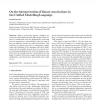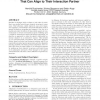770 search results - page 15 / 154 » Subsequence similarity language models |
SOSYM
2002
13 years 8 months ago
2002
Binary associations between classifiers are among the most fundamental of UML concepts. However, there is considerable room for disagreement concerning what an association is, sema...
COMPUTER
2002
13 years 8 months ago
2002
rs use models or abstractions that hide low-level implementation details. Various kinds of representations such as data models, state-transition models, and dataflow models can hel...
LREC
2010
13 years 10 months ago
2010
The SignSpeak project will be the first step to approach sign language recognition and translation at a scientific level already reached in similar research fields such as automat...
ATAL
2010
Springer
13 years 9 months ago
2010
Springer
Speakers in dialogue tend to adapt to each other by starting to use similar lexical items, syntactic structures, or gestures. This behaviour, called alignment, may serve important...
SIGMOD
1998
ACM
14 years 21 days ago
1998
ACM
Most databases contain “name constants” like course numbers, personal names, and place names that correspond to entities in the real world. Previous work in integration of het...


